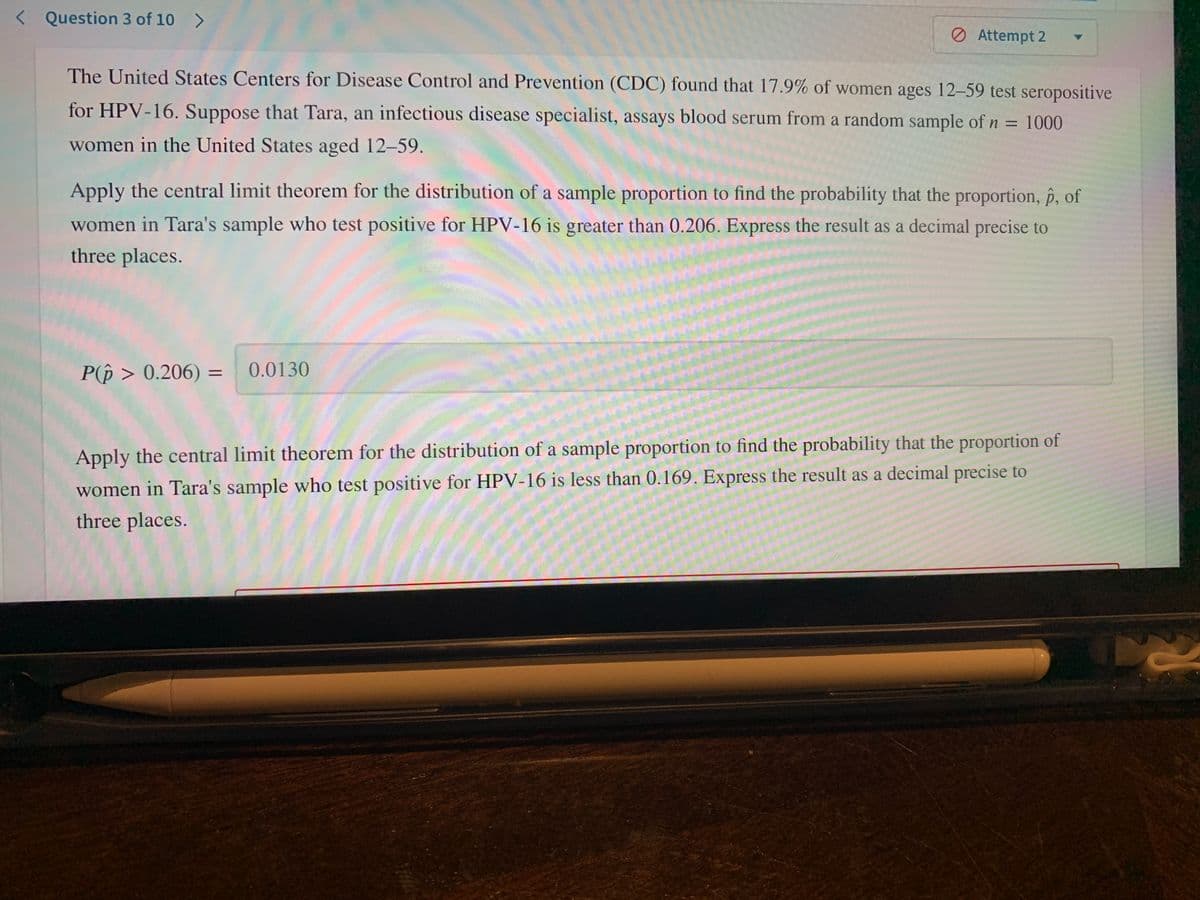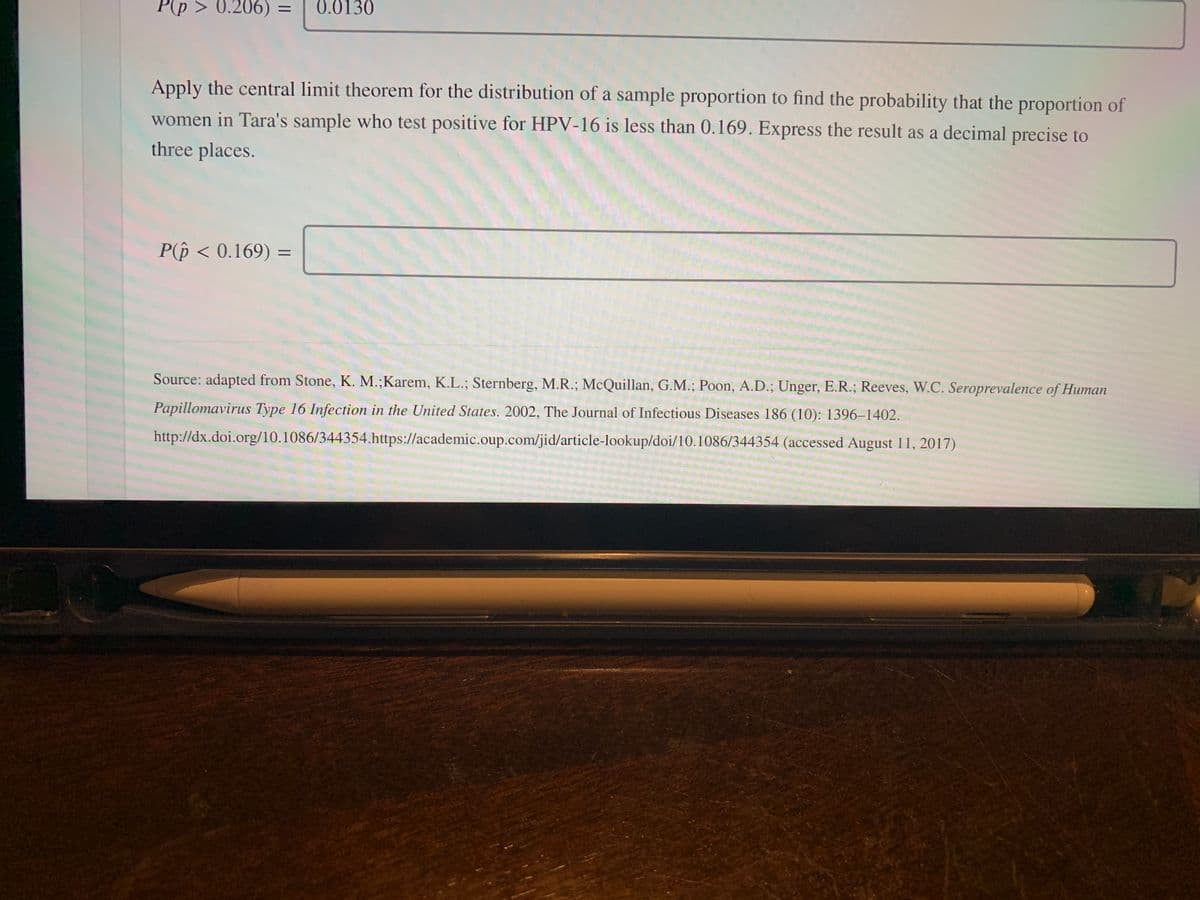Apply the central limit theorem for the distribution of a sample proportion to find the probability that the proportion of women in Tara's sample who test positive for HPV-16 is less than 0.169. Express the result as a decimal precise to three places. P(p < 0.169) = Source: adapted from Stone, K. M.;Karem, K.L.; Sternberg, M.R.; McQuillan, G.M.; Poon, A.D.; Unger, E.R.; Reeves, W.C. Seroprevalence of Human Papillomavirus Type 16 Infection in the United States. 2002, The Journal of Infectious Diseases 186 (10): 1396-1402. http://dx.doi.org/10.1086/344354.https://academic.oup.com/jid/article-lookup/doi/10.1086/344354 (accessed August 11, 2017)
Apply the central limit theorem for the distribution of a sample proportion to find the probability that the proportion of women in Tara's sample who test positive for HPV-16 is less than 0.169. Express the result as a decimal precise to three places. P(p < 0.169) = Source: adapted from Stone, K. M.;Karem, K.L.; Sternberg, M.R.; McQuillan, G.M.; Poon, A.D.; Unger, E.R.; Reeves, W.C. Seroprevalence of Human Papillomavirus Type 16 Infection in the United States. 2002, The Journal of Infectious Diseases 186 (10): 1396-1402. http://dx.doi.org/10.1086/344354.https://academic.oup.com/jid/article-lookup/doi/10.1086/344354 (accessed August 11, 2017)
MATLAB: An Introduction with Applications
6th Edition
ISBN:9781119256830
Author:Amos Gilat
Publisher:Amos Gilat
Chapter1: Starting With Matlab
Section: Chapter Questions
Problem 1P
Related questions
Question

Transcribed Image Text:< Question 3 of 10 >
Ø Attempt 2
The United States Centers for Disease Control and Prevention (CDC) found that 17.9% of women ages 12-59 test seropositive
for HPV-16. Suppose that Tara, an infectious disease specialist, assays blood serum from a random sample of n = 1000
women in the United States aged 12-59.
Apply the central limit theorem for the distribution of a sample proportion to find the probability that the proportion, p, of
women in Tara's sample who test positive for HPV-16 is greater than 0.206. Express the result as a decimal precise to
three places.
P(p > 0.206) =
0.0130
Apply the central limit theorem for the distribution of a sample proportion to find the probability that the proportion of
women in Tara's sample who test positive for HPV-16 is less than 0.169. Express the result as a decimal precise to
three places.

Transcribed Image Text:P(p > 0.206) =
0.0130
Apply the central limit theorem for the distribution of a sample proportion to find the probability that the proportion of
women in Tara's sample who test positive for HPV-16 is less than 0.169. Express the result as a decimal precise to
three places.
P(p < 0.169) =
%3D
Source: adapted from Stone, K. M.;Karem, K.L.; Sternberg, M.R.; McQuillan, G.M.; Poon, A.D.; Unger, E.R.; Reeves, W.C. Seroprevalence of Human
Papillomavirus Type 16 Infection in the United States. 2002, The Journal of Infectious Diseases 186 (10): 1396–1402.
http://dx.doi.org/10.1086/344354.https://academic.oup.com/jid/article-lookup/doi/10.1086/344354 (accessed August 11, 2017)
Expert Solution
This question has been solved!
Explore an expertly crafted, step-by-step solution for a thorough understanding of key concepts.
This is a popular solution!
Trending now
This is a popular solution!
Step by step
Solved in 2 steps with 1 images

Knowledge Booster
Learn more about
Need a deep-dive on the concept behind this application? Look no further. Learn more about this topic, statistics and related others by exploring similar questions and additional content below.Recommended textbooks for you

MATLAB: An Introduction with Applications
Statistics
ISBN:
9781119256830
Author:
Amos Gilat
Publisher:
John Wiley & Sons Inc

Probability and Statistics for Engineering and th…
Statistics
ISBN:
9781305251809
Author:
Jay L. Devore
Publisher:
Cengage Learning

Statistics for The Behavioral Sciences (MindTap C…
Statistics
ISBN:
9781305504912
Author:
Frederick J Gravetter, Larry B. Wallnau
Publisher:
Cengage Learning

MATLAB: An Introduction with Applications
Statistics
ISBN:
9781119256830
Author:
Amos Gilat
Publisher:
John Wiley & Sons Inc

Probability and Statistics for Engineering and th…
Statistics
ISBN:
9781305251809
Author:
Jay L. Devore
Publisher:
Cengage Learning

Statistics for The Behavioral Sciences (MindTap C…
Statistics
ISBN:
9781305504912
Author:
Frederick J Gravetter, Larry B. Wallnau
Publisher:
Cengage Learning

Elementary Statistics: Picturing the World (7th E…
Statistics
ISBN:
9780134683416
Author:
Ron Larson, Betsy Farber
Publisher:
PEARSON

The Basic Practice of Statistics
Statistics
ISBN:
9781319042578
Author:
David S. Moore, William I. Notz, Michael A. Fligner
Publisher:
W. H. Freeman

Introduction to the Practice of Statistics
Statistics
ISBN:
9781319013387
Author:
David S. Moore, George P. McCabe, Bruce A. Craig
Publisher:
W. H. Freeman